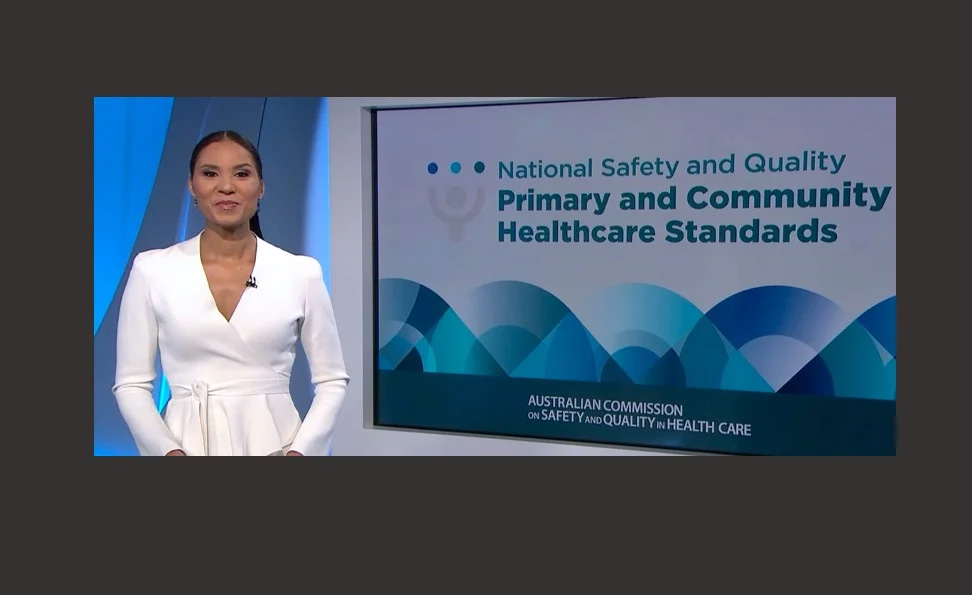
Image above: TV presenter Janice Peterson hosted the webcast launch of the new standards. Photo supplied by the Commission.
This article was written by Conjoint Professor Anne Duggan and first published on Croakey.org
North Western Melbourne Primary Health Network (NWMPHN) is a member of the Croakey funding consortium. We encourage you to support and subscribe to Croakey.
Primary care and community health services have been urged to engage with new National Safety and Quality Primary and Community Healthcare Standards, launched last month.
Accreditation to the new Standards will be voluntary and is due to begin from mid-2022, writes Conjoint Professor Anne Duggan, Chief Medical Officer at the Australian Commission on Safety and Quality in Health Care.
Anne Duggan writes:
Our healthcare system is widely acknowledged as one of the best in the world. Australians expect safe and high-quality care from our healthcare providers, including hospitals and day care procedure services. In Australia, all public and private hospitals, day procedure services and most public dental practices must be accredited against the National Safety and Quality Health Service (NSQHS) Standards, under the Australian Health Service Safety and Quality Accreditation (AHSSQA) Scheme.

Accreditation is a program in which trained external reviewers assess a health service organisation’s implementation of the NSQHS Standards. Assessment involves an on-site visit during which surveyors seek evidence of implementation against the actions in the NSQHS Standards.
Surveyors assess a hospital’s performance during an accreditation visit of up to five days, during which they interview clinical staff, patients, consumer representatives, review hospital performance data such as hospital-acquired complications, observe clinical practice, inspect resources and test high-risk scenarios.
Assessment against the NSQHS Standards and the awarding of accreditation status provides assurance to the community that a health service organisation has the safety and quality systems and processes in place to meet expected patient safety and quality standards of care.
The reduction in patient harm due to local implementation of the NSQHS Standards is unequivocal. Significant advances in patient safety have yielded better documentation of adverse drug reactions and medication history, and declining rates of in-hospital cardiac arrest and intensive care unit admissions following cardiac arrests, among other improvements.
Filling a gap
Outside the acute sector, the picture is quite different. Without national standards, it is difficult for a healthcare consumer to discern which healthcare services are safe and appropriate for them across the vast primary and community sector.
The new National Safety and Quality Primary and Community Healthcare Standards – launched in October by the Hon Greg Hunt MP, Minister for Health and Aged Care – will provide the right framework to raise the bar across the sector.
Before their release, there was a gap.
Until now, the only nationally consistent safety and quality standards for healthcare services were those linked to the acute sector. The primary and community health sector had responded in a variety of ways. Some professions with the capability and resources developed and maintained their own standards, such as community pharmacy and general practice.
Others, including over 3,100 private dental practices, physiotherapists and audiologists, have implemented the NSQHS Standards, while some followed standards specific to their healthcare sector, such as aged care or the National Disability Insurance Scheme. For the remainder there were no national and safety standards.
The Primary and Community Healthcare Standards were developed after extensive public consultation and engagement with an industry-based advisory group. Consultation is at the heart of everything the Australian Commission on Safety and Quality in Health Care (the Commission) does.
The Commission is pleased the new Standards have received a warm reception from the primary and community health sector. The Standards will be implemented to protect patients from harm. The Standards give Australians confidence to make informed decisions about healthcare services and to know what to do if they are concerned about the healthcare they receive.
Applying a framework to local healthcare
In simple terms, the Standards require practices to set up safety and quality processes to reduce the risk of patients being harmed. The Standards can be applied to any primary care service – no matter the type of service, where it is located or how small it may be.
Comprising three standards, the first Clinical Governance Standard embeds a risk-management and continuous improvement approach.
The second, Partnering with Consumers Standard, describes how healthcare services should support meaningful partnerships with patients and consumers, through communication and information. This enables people to make informed decisions about their own healthcare.
Finally, the Clinical Safety Standard provides a framework to address and minimise common safety and quality risks. It covers important areas such as preventing and controlling infections, medication safety, communicating and responding to serious deterioration.
The Standards support services to:
- Embed a person-centred approach in the delivery of healthcare
- Establish and maintain systems for integrating care, communication and multi-disciplinary collaboration
- Understand and address the unique needs of Aboriginal and Torres Strait Islander people, and other populations at greater risk of avoidable differences in health outcomes, including people with disability and people with diverse backgrounds
- Embed a culture of continuous quality improvement, driven by data, outcomes and best practice care
- Prepare for preventing, controlling and responding to infections that cause outbreaks, epidemics or pandemics.

Montage created by the Commission, indicating the diverse settings where the new standards may apply.
A staged approach to accreditation
Accreditation to the new Standards will commence from mid-2022. The Commission is developing an assessment model under the AHSSQA Scheme. Accreditation to these new Standards will be voluntary.
Currently, more than 3,100 private primary and community healthcare services are accredited to the NSQHS Standards. These services are likely to transition to the Primary and Community Healthcare Standards when they are due for re-accreditation.
There has also been much interest from community health services linked to public local health networks; state and territory health departments will determine whether these Standards can be adopted.
For healthcare services already accredited to profession-specific standards, such as general practice and community pharmacy, there will be no change.
However, the Commission sees real advantages for patients in greater alignment between profession-specific standards and the Primary and Community Healthcare Standards. The Commission will be working with other organisations on a nationally consistent approach.
Where to from here?
The Commission strongly encourages primary and community healthcare services to implement the Standards.
Healthcare services wanting more practical support will be pleased to know the Commission is working on a suite of resources to implement and transition to the Standards. These are due for release in 2022. For services planning to transition from the NSQHS Standards, it would be prudent to become familiar with the new Standards.
If COVID-19 has taught us anything, it is that we need to be prepared, and to have established ways of working that are reviewed regularly using a risk-based, continuous improvement approach.
The Standards are an ideal framework to do this; so for services that consider themselves ‘too busy’ to implement them, it will be a missed opportunity that will leave patients and consumers worse off.
Make your health service an early adopter of the new Standards and your healthcare service and patients will be better off.




